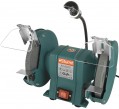Motor power
Rated power of the electric motor of the machine. The more powerful the engine, the higher the speed and intensity of processing can be, the larger discs can be used with the machine and the better it is suitable for working with hard, stubborn materials. On the other hand, a powerful motor consumes a lot of energy (which may require special connection — see "Power") and significantly affects the dimensions, weight and price of the entire unit. Therefore, manufacturers choose this parameter based on the type (see "Machine") and the desired characteristics of speed, productivity, etc. In fact, this means that engine power is rather a secondary parameter, and when choosing, it makes sense to pay attention to more practical points — disk diameter, rotation / movement speed, etc.
Bore diameter
The bore diameter of the dry cutting discs (see above) used by the machine. In order for the nozzle to be used normally with the machine, it must match it not only in diameter and thickness (see the relevant paragraphs), but also in the size of the mounting hole.
Disc thickness
The thickness of the "dry" blade (see "Dry Machining") for which the machine is designed. Usually, we are talking about the maximum thickness of the disc that can fit on the seat — most models allow the use of thinner nozzles.
Note that this parameter depends on the type of sharpening (see above): working with chains and saw blades involves a small thickness of the discs, universal sharpening is the opposite. And for grinding models, the thickness of the disc is not relevant at all, even if the disc is provided in the design; see "Machine" for details.
LED light
The presence of its own
illumination in the design of the machine. Usually, such a system takes the form of a lamp attached to the body with a flexible leg. It allows you to brightly illuminate the work area, which is important not only at dusk or darkness, but even in daylight (protective covers and other parts can greatly obscure the working element of the machine).

